How to use Telephoto Lenses for Nature Photography
Telephoto lenses are mostly an afterthought for landscape photography, especially for beginner landscape photographers. However, telephoto lenses allow us to capture some unique and stunning photos for our portfolios that are not possible with wide angle lenses. Telephoto lenses are not easy to use. They do require a different mindset and camera settings to use them effectively.
The following are a few of the challenged that you may face when using telephoto lenses and some tips on how to overcome them:
Tips for Using a Telephoto Lens
Getting Sharp Focus
One of the biggest challenges that landscape photographers face when using a telephoto lens is getting everything in sharp focus. The long focal length combined with incorrect aperture setting and focus point results in soft images. I highly encourage you to be comfortable using the right focus settings with a telephoto lens before you decide to take on a workshop. I also recommend that you get into the habit of using the back of your camera to check your captured landscape photos to ensure they are in sharp focus.
Overcoming Camera Shake
Besides using wrong focus settings, blurry photos with telephoto lenses are often associated with camera shake. If you are not using a tripod with your telephoto lens, it is best to use a fast shutter speed. As a rule of thumb, the minimum shutter speed needed to overcome camera shake should be the inverse of the focal length on a full frame camera. For static landscape photography, we almost always prefer to use a sturdy tripod and remote release or two-second timer when photographing with a telephoto lens.
Subject Motion
Aside from camera motion, subject motion can also create problems when using a telephoto lens. A fast moving subject such as wildlife or falling water requires a very high shutter speed to freeze the motion. Your choice of shutter speed depends upon what you are trying to accomplish with your telephoto lenses. I used an extremely fast shutter speed to freeze the motion of the water in this landscape photo from Iceland.
Depth of Field
The long focal length of a telephoto lens often results in a narrow depth of field. There are not hard or fast rules about choosing the correct depth of field. We rely on the subject distance and our focus setting to get an ideal depth of field. After taking a shot, we always zoom into the photo on the back of our camera to make sure that the image is how we envisioned it. If it’s not, we change the focus setting and aperture value and repeat the process.
Landscape Photography Composition
This challenge is often overlooked by beginner landscape photographers. The small movements of a telephotos lens can make big changes in your landscape photography composition when using a long focal length.
You may also encounter “photography composition creep” if you use a tripod ball head that cannot hold the weight of your telephoto and camera combination. This manifests itself with a slow changing of your landscape photography composition after you lock the tripod and ball head in place. The best way to overcome this is use a tripod ball head that is strong enough to hold your weight of the camera, telephoto lens and any accessories that you are using to capture the photo. lens securely.
Finally, you must think about which focusing options and camera settings work best for the landscape photo you are trying to capture. This requires a logical and creative landscape photography workflow as seen from the following example.
Landscape Photography with a Telephoto Lens
This is a photo from the Florida Everglades. I was struck by the beauty of the rising sun over the distant horizon. Unfortunately, my wide-angle lens would not have done justice to the scene. The fact is, this incredible golden color was only present right around the rising sun. The rest of the sky was a bright, clear blue – and these were the only visible clouds.
So, I put the wide-angle lens away and pulled out my 135mm prime. The longer lens let me fill the frame with gold – leaving me with an extremely simple, monochromatic color scheme. The sun calls out for attention and I also included a small stand of dwarf cypress trees as a secondary point of interest. I chose a diagonal composition for a more dynamic image… and to compliment the angle of the sunbeams.
I needed to think fast for this shot. A few more seconds and the sun and clouds had shifted their positions. I wanted the sun just peeping out from behind the cloud as you see it here. Luckily, aside from a quick lens change, very little setup was required. I didn’t need a GND filter, since the range of light is actually relatively even. And a circular polarizer won’t do much for you if you are shooting directly in to the sun… so I didn’t need that either. I did use a tripod – more out of habit than anything else. My shutter speed was 1/640 sec, so I could have hand-held the shot without a problem.
Post-processing took just a few minutes. I chose the color balance carefully – making sure that the golden light seemed to glow. An incorrect color balance would have left this image feeling dull and heavy. And with light like this, that would have been a crime!
I was also careful to control the blown highlights in this shot. It’s perfectly acceptable to have blown highlights in an image when you are shooting directly into the sun. If you look directly at the real sun, can you see detail there? Of course not. So, reducing the brightness of the sun would result in an extremely unnatural-looking image. On the other hand, the last thing I wanted to do was end up blowing out half my sky. So, I kept a close eye on my histogram and kept my adjustments very controlled.
A little bit of contrast – not too much. No saturation adjustment necessary. That’s about it.
Action Photography with a Telephoto Lens
After our Hawaii workshop, Jay and I took a drive with a few remaining students to explore the coastline on the eastern point of the Big Island of Hawaii. At one rocky overlook, big turquoise waves rolled ashore. So, we pulled out our 70-200mm telephoto lens to capture waves in action.
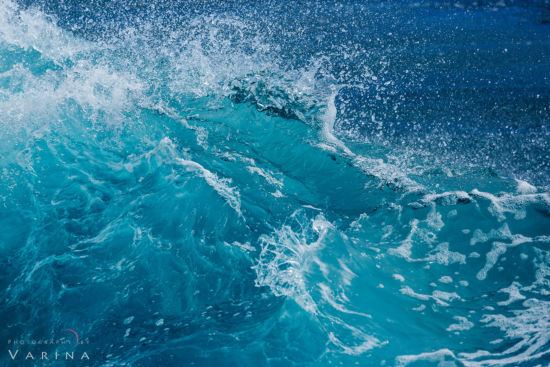
Abstract nature photography using focus tracking mode & fast shutter speed with a telephoto lens in Hawaii
Photographing fast moving waves with a telephoto lens requires a completely different workflow than shooting static landscape photos. Camera exposure and getting the waves in sharp focus requires a well thought-out strategy. You also must be fairly quick to compose your photo to capture the action when it is happening.
Here is my detail telephoto lens workflow to capture waves in action:
- Photograph at midday under a cloudless sky: We’re always telling you to look for soft light for nature photography. But this is an exception to that rule. Bright sunlight during midday will penetrate deep into the waters, bringing out the brilliant tropical colors in the wave. Light at midday with a cloudless sky will not change for several hours. This allowed me to fix my camera exposure before I started photographing waves.
Alternatively, you can select heavy overcast skies to photography waves. However, the colors in the water will be more muted.
- Direction of light matters: You probably know that harsh sunlight produces bright glare and reflections on the surface of the water – and blown highlights are not desirable for nature photography. So, pay attention to the angle of the sun when photographing waves.
Face the water, look to your left, and then to your right. Depending upon the angle of the sun, you may notice that those bright highlights on the water almost disappear when you are looking in one direction. If that’s the case, shoot in that direction! It’s the easiest way to deal with the problem. When I arrived at the location I chose a photography composition to minimize the glare and capture the brilliant colors without the help of a circular polarizer.
- Location also matters: Of course, the location itself is equally important. You’ve seen photos that look right into the barrel of the wave, right? If you want shots like that, you need to put yourself in the right place at the right time. You need big waves that form barrels as they break – and you’ll need to be in the right place to capture a shot looking into them.
For the shot below, we stood on a high cliff at Miloli’i. The spot we choose jutted out beyond the beach below, so we could shoot along the length of the wave as it rolled past us.
- Fast shutter speed: And finally, be sure to use a fast shutter speed. I like to keep mine around 1/1000 of a second in order to freeze the spray as it flies through the air. Sunny skies help with that, but you may need to open up your aperture a bit or use a higher ISO to get a fast enough shutter speed.
- Choose optimal focus setting: Because I was using a narrow aperture with a telephoto lens, I ended up with extremely narrow depth of field. So getting details of the fast moving waves in sharp focus required careful planning and choosing the correct focus settings. I used a focus tracking mode and a single point focus to follow the wave as it came towards the shore. This allowed me to capture several wave photos sharply in focus as the waves came towards the shore.
As you can see, telephoto lenses can be challenging to use. But with a well-defined landscape photography workflow, you can capture some amazing photos.
By the way, if you’re going to shoot waves, you’d better bring along a few extra memory cards. The shifting seascape makes it difficult to pack up and leave, since the next wave is surely the one! ;)

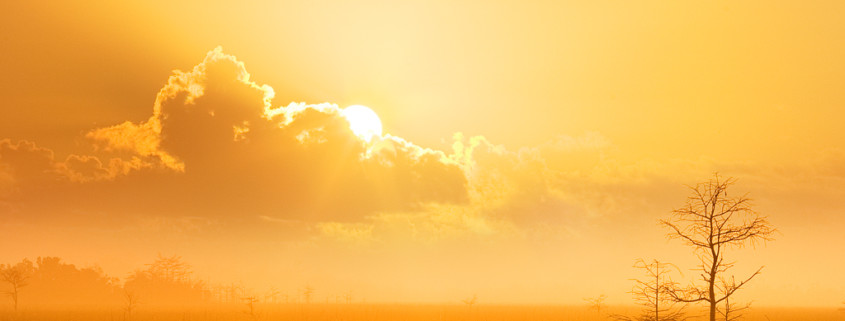



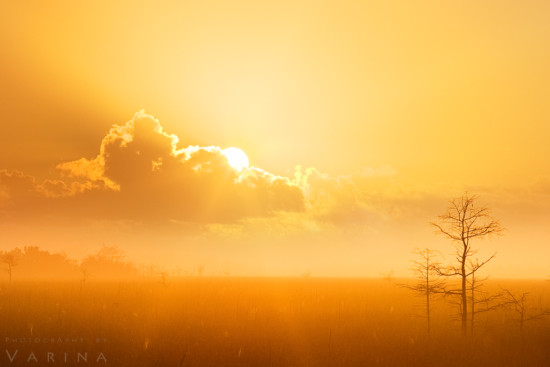

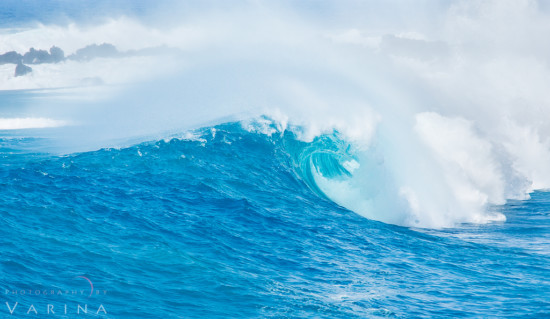

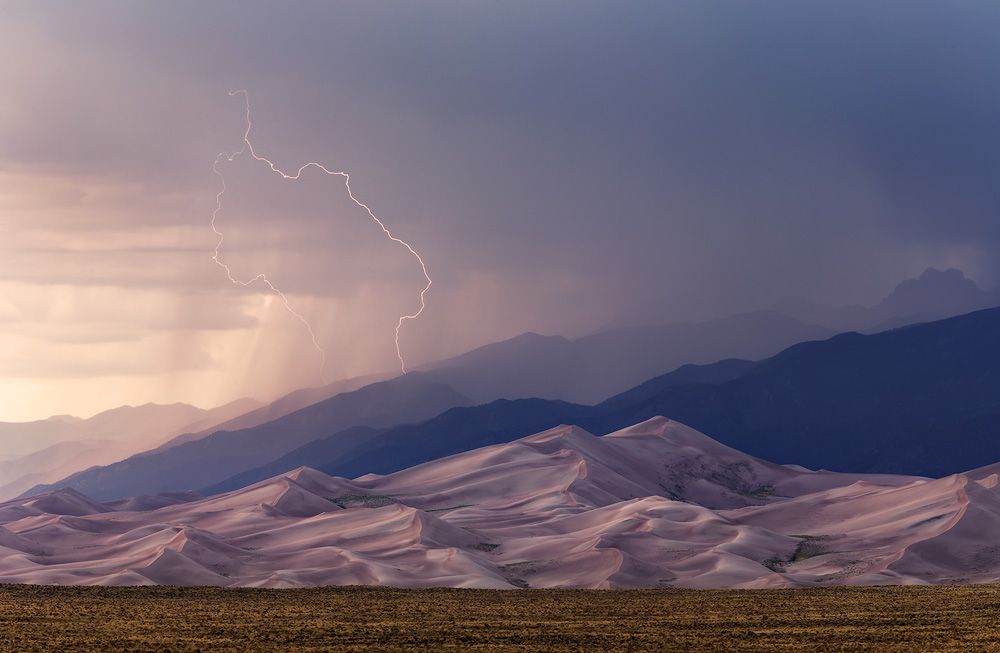
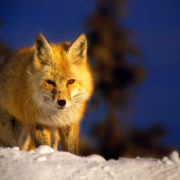



This is a beautiful shot. I appreciate your description of the composition.
On the topic of colour balance, I find that leaving my colour balance set to daylight, rarely disappoints when shooting with available light. If a colour cast is to severe, it cam always be corrected when processing the raw file. In this shot, the warm golden colour of the shot would have been lost if auto white balance or incandescent colour balance had been used. Often the strong colour cast of a photo is what makes the photo great.
A great shot. Also love the tips, will have to keep this in mind.
Thanks Ratul!
Beautiful! A winner in my book!
Thanks Shawn!